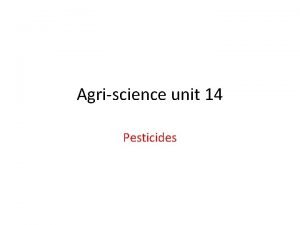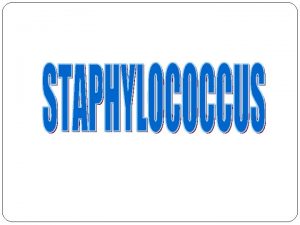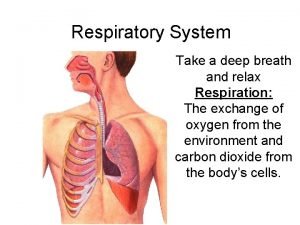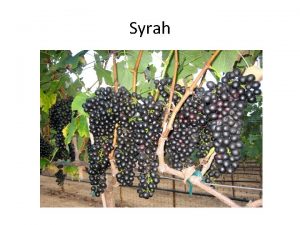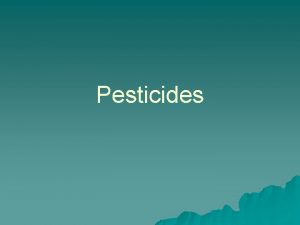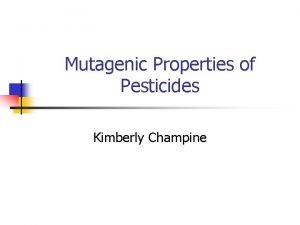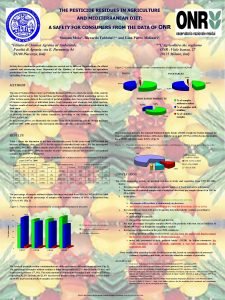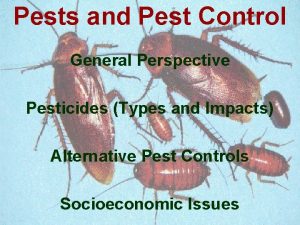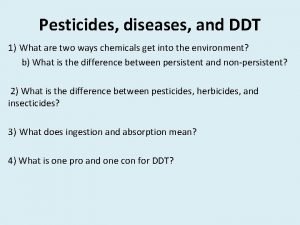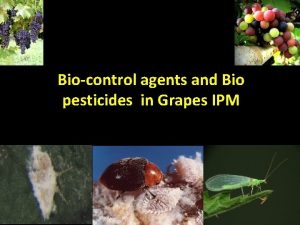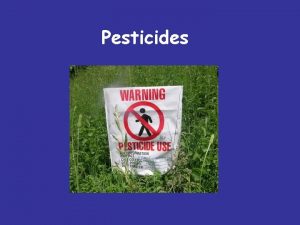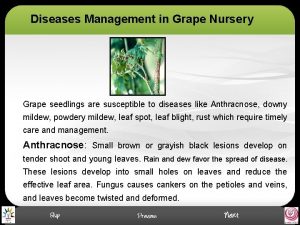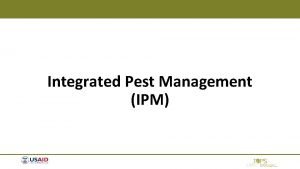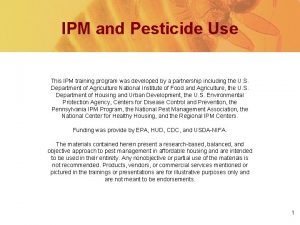Pesticides use in grapes IPM INTRODUCTION v Grape













- Slides: 13

Pesticides use in grapes IPM INTRODUCTION v Grape is an important commercial horticulture crop cultivated throughout India. v A wide range of pesticides are used for the better yield of grape due to pest infestation throughout the season of the crop. Next

Pesticides in IPM q Integrated Pest Management (IPM) is a judicious combination of feasible pest management components to keep insects below economic injury level. q Various components of IPM include resistant varieties, cultural methods, physical methods, Mechanical methods, Biological control and Pesticides. q Inspite of their glorious past and great potential, pesticides is playing an important part as a component of sustainable IPM programmes which should be used on need basis. End Previous Next

Benefits of Pesticides in IPM 1. Easily available. 2. Greater control confidence. 3. Effective and rapid control. 4. Management efficiency. 5. Can enable other management practices. Due to their efficacy, convenience, flexibility and economy, pesticides played a major role in crop production. But the intensive, extensive and misuse of pesticides caused widespread damage to the environment and human health, development of resistant pests etc. , End Previous Next

What can be done? v Use of appropriate pesticide in right dose at right time holds the key for effective pest management. v Indiscriminate use of pesticides not only adds to the cost of production significantly, but also results in pesticide residues in the final produce and also in soil and water. v Although pesticides are targeted at insect pests and diseases, many have deleterious effects on natural enemies. v Use selective pesticide that is least detrimental to beneficial species, yet still effective against the targeted species (eg. , Neem). End Previous Next

Go for Judicious use of pesticides ü Regular monitoring of pests should be done in the vineyards to assess the level of pest population. ü Need for pesticide use should be determined only if pest incidence tends to approach economic threshold level (ETL). ü Growers should use only the pesticides which are permitted for use in grapes by Central Insecticides Board (CIB), Faribabad / National Research Centre for Grapes (NRCG), Pune. ü Do not mix any pesticides, growth regulators and any other chemicals without verifying their compatability. End Previous Next

Problem of pesticide residues • Grape is one of the important fresh fruit being exported to European Union countries besides the countries of Middle East and the Far East. • Pesticide residue in the grapes is one of the quality parameters before the importers in the EU countries to accept the produce. • During the export season of 2002 -2003, some of the exported consignments had the pesticide residue more than the maximum residue level (MRL). • As a result, European Union ordered testing of pesticide residue in all the consignments. • This action led to delay in sale of the produce in the market and also rejection of some consignment. (Source: http: //nrcgrapes. nic. in/National%20 Referral%20 Laboratory. htm) End Previous Next

Awareness to be created on v Improve the grower knowledge about weather conditions conducive for disease and pest outbreaks v Critical times to apply sprays for effective control v Selection of the appropriate chemical for each disease/pest v Training must be given to grape growers in the safe handling of chemical pesticides is required to reduce the risk of contamination, both to the environment and vineyard workers. End Previous Next

Mealy bugs: v Foliar spray of Malathion 50 EC @ 2 ml/l or Methomyl 40 SP @ 1 g/l or Dichlorvos 76 WSC @ 2 ml/l reduce mealy bug population. v Swabbing of stem and arms with 2 ml of Dichlorvos 76 EC + 2 g of fish oil resin soap in a litre of water (incidence is sporadic). Thrips, Hoppers and Flea beetles: v Foliar spray of Imidacloprid 200 SL @0. 3 ml/l or Thiamethoxam 25 WG @0. 25 g/l or Lambdacyhalothrin 5 EC @0. 5 ml/l. End Previous

Stem girdler: v Main stem of grape can be protected by wrapping a piece of cloth soaked in an insecticide like chloripyriphos. Flea beetles: v Foliar spray of Carbaryl 50 WP @2 g /l. Mites: v Foliar spray of Difenthiuron @ 0. 8 g/l End Previous Next

Grapevine Stem Borer: v Insertion of ½ tablet of aluminium phosphide in each hole and plugging with mud was found to kill the stem borer in the holes. v Injecting vines with 2 ml of Dichlorvos 76 % EC. End Previous Next

Downy mildew: v Spray 1% Bordeaux mixture as preventive measure. v Three sprays of Metalxyl+Mancozeb 72 WP @ 2. 5 g/l or Fosetyl AI @ 3 g/l to cover vines for 15 -30 days. v Spray copper fungicides (Copper hydroxide 2 g/l or COC 3. 0 g/l) or any other non systematic fungicides viz. , captan, mancozeb, chlorothalnil @ 2 g/l after 3 to 4 days after 2 nd or 3 rd spray of systemic fungicides. Anthracnose: v Spray of copper fungicides suggested for control of downy mildew will also controls anthracnose. End Previous Next

Powdery mildew • Spray Sulfur @ 2. 0 g/l or Potassium bicarbonate @5. 0 g/l if powdery mildew is noticed. • Four spray of any of the following fungicide at 10 day intervals from fruit set to veraison stage. Spray Penconazole @ 0. 5 ml/l (Pre harvest Interval (PHI - 50 days), or Flusilazole @ 25 ml/l (PHI - 50 days) or Tridemefon @1. 0 g /l (PHI- 45 days). End Previous Next

Let’s sum up ü Grape cultivation relies on wide range of pesticides for its better yield due to pest infestation throughout the season of the crop. ü Use of appropriate pesticide in right dose at right time holds the key for effective pest management. ü Use of selective insecticides will protect the natural enemies from adverse effect of pesticides. ü Need based application of pesticides will continue to play an important part as a component of sustainable IPM programmes. ü Training must be given to grape growers in the safe handling of chemical pesticides is required to reduce the risk of contamination, both to the environment and vineyard workers. End Previous Next
 Unit 14 safe use of pesticides
Unit 14 safe use of pesticides Grape countable or uncountable
Grape countable or uncountable Cocci in grape-like clusters
Cocci in grape-like clusters Grape life cycle
Grape life cycle Respiratory system
Respiratory system Grape sherbet poem
Grape sherbet poem Grape solar 390w
Grape solar 390w Dark skinned grape
Dark skinned grape Logo diffusion
Logo diffusion The pros and cons of pesticides
The pros and cons of pesticides Classification of insecticides
Classification of insecticides Mediterranean diet pesticides
Mediterranean diet pesticides Different types of pesticides
Different types of pesticides Example of pesticides
Example of pesticides
